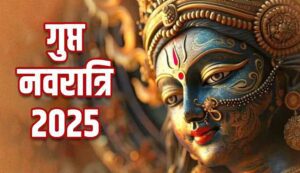Ashadha Gupt Navratri 2025: Know the secret and importance behind calling Ashadh Navratri as Gupt Navratri
Ashadha Gupt Navratri 2025: The celebration of Navratri is a representation of Shakti and Mother Durga adoration in Hinduism. There are four Navratris in a year, with Sharadiya and Chaitra Navratri being extensively observed as festivals and Magh and Ashadh Navratris being referred to as Gupta Navratri. During the Shukla Paksha of Ashadh month, Ashadh Gupta Navratri is observed. It is particularly crucial for Sadhaks and Tantrikas. Tell us about Ashadh Gupta’s Navratri secrets.

Ashadh Gupta Navratri Secrets
Gupta Ashadh In Hinduism, Navratri has particular significance, particularly for Sadhaks who are committed to achieving spiritual achievements and the Tantra-Mantra. Ten Mahavidyas—Maa Kali, Tara Devi, Tripura Sundari, Bhuvaneshwari, Chhinnamasta, Tripura Bhairavi, Dhumavati, Baglamukhi, Matangi, and Kamala Devi—as well as nine manifestations of Mother Durga are worshipped during this Navratri. Each of these Mahavidyas has a unique meaning and represents many types of power.
For Tantrikas and Aghoris, Gupt Navratri is a unique occasion. In order to achieve spiritual abilities, wisdom, prosperity, and success, Tantra-Mantra is performed covertly throughout this period. It is said that the Sadhak might get specific siddhis from the practice performed over these nine days.
During Gupt Navratri, 10 Mahavidyas are worshipped in a unique rite. While worshiping Maa Bhuvaneshwari is seen to be beneficial for obtaining esteem and children, worshiping Maa Kali is done for freedom from adversaries and evil forces. For every Mahavidya, a certain mantra is recited.
Legend has it that during the ancient Vedic era, only Siddha Sadhaks and saints celebrated Gupt Navratri. During this period, people might covertly worship Mother Durga and benefit from her heavenly graces. Goddess Durga is particularly revered during Gupta Navratri, according to another tradition, and was created to slay demons like Mahishasura.
Reciting literature such as Durga Saptashati, Devi Mahatmya, and Shrimad-Devi Bhagwat is seen as auspicious during Gupta Navratri. Chanting the 32 names of Durga Battisi also provides tranquility and eliminates all of life’s troubles.
Why is the name Gupt given to Ashadh Gupta Navratri?
Gupta Ashadha Navratri is known as “Gupta” since it is not observed as widely as other Navratris, such as Sharadiya and Chaitra. There are several explanations for this.
During Gupt Navratri, worship and sadhana are kept private. Tantrikas and Sadhaks carry out their sadhana in secrecy and do not disclose it to the public. This is because the practice of Tantra-Mantra places a great value on secrecy in order to preserve Sadhana’s efficacy.
While Tantric and sometimes Tamasik Puja—which involves the usage of meat and alcohol—are utilized during Gupt Navratri, Satvik Puja is common throughout regular Navratris. The public is not allowed to attend this puja, which is specifically for the accomplishment of Siddhis.
For sadhaks, Gupt Navratri is a unique time since sadhana performed during this period is said to enable the attainment of siddhis and unusual abilities. Because of this, it is kept under wraps to prevent any obstacles to the sadhana.
Similar to Sharadiya and Chaitra Navratri, Gupt Navratri does not get much publicity. It is mostly intended for those who are drawn to tantric and spiritual sadhana.

